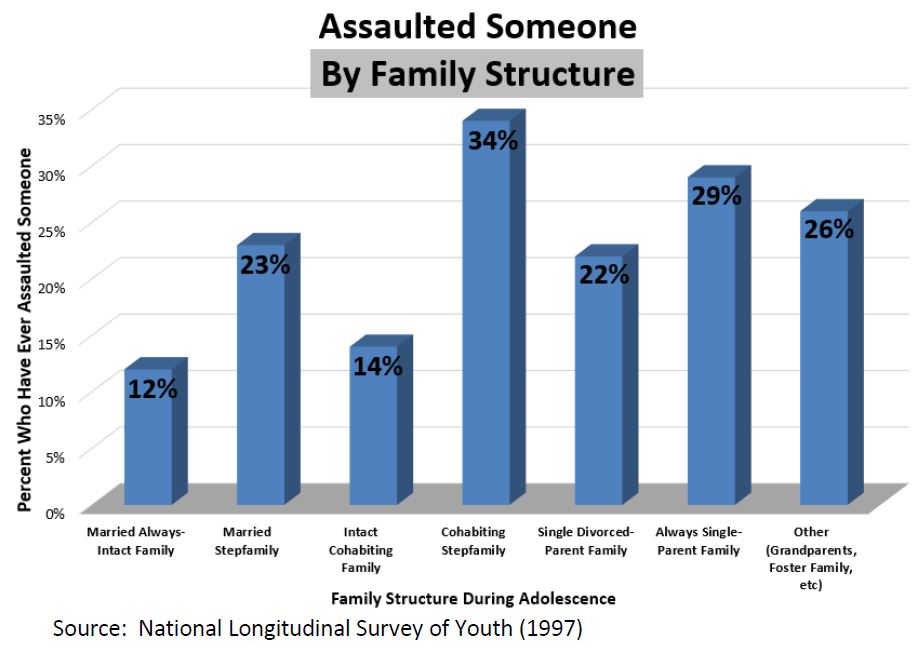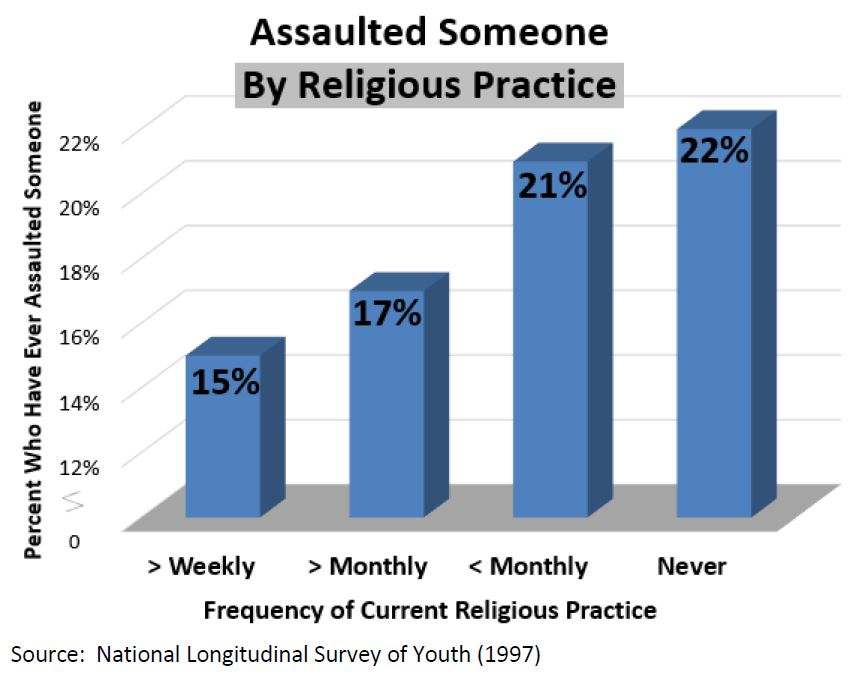Click Here to download “Assaulted Someone by Family Structure and Religious Practice”
Assaulted Someone by Family Structure and Religious Practice
According to the 1997 National Longitudinal Survey of Youth, adults who grew up in intact families who frequently attended religious services at the time of the survey were least likely to have ever assaulted someone. [1] Family Structure: According to the 1997 National Longitudinal Survey of Youth, 12 percent of adults who grew up with both biological married parents committed assault in their lifetime. After those who grew up in intact families, those who grew up in an intact, cohabiting family were least likely to commit assault (14 percent), followed by those who grew up in a divorced single-parent family (22 percent), those who grew up in a married stepfamily (23 percent), those who grew up in an alternate family structure [i.e. with grandparents, in foster homes, etc.] (26 percent), and those who grew up with an always single parent (29 percent). Those who grew up in a cohabiting stepfamily were most likely to commit assault (34 percent). Religious Practice: The 1997 National Longitudinal Survey of Youth shows that 15 percent of those who attended religious services at least once per week at the time of the survey committed assault. They were followed by those who attended services at least monthly (17 percent) and those who attended less than monthly (21 percent). Adults who never attended religious services were most likely (22 percent) to ever have assaulted someone.
Religious Practice: The 1997 National Longitudinal Survey of Youth shows that 15 percent of those who attended religious services at least once per week at the time of the survey committed assault. They were followed by those who attended services at least monthly (17 percent) and those who attended less than monthly (21 percent). Adults who never attended religious services were most likely (22 percent) to ever have assaulted someone.
 Family Structure and Religious Practice Combined: Based on the 1997 National Longitudinal Survey of Youth, 11 percent of adults who worshipped weekly and grew up in intact families had committed assault. By contrast, 25 percent of adults who never attended religious services and came from “other family structures” had assaulted someone. Between these two extremes were those who never worshipped and grew up in intact families (15 percent) and those who attended religious services weekly but grew up in “other” family structures (22 percent).
Family Structure and Religious Practice Combined: Based on the 1997 National Longitudinal Survey of Youth, 11 percent of adults who worshipped weekly and grew up in intact families had committed assault. By contrast, 25 percent of adults who never attended religious services and came from “other family structures” had assaulted someone. Between these two extremes were those who never worshipped and grew up in intact families (15 percent) and those who attended religious services weekly but grew up in “other” family structures (22 percent).
 Related Insights from Other Studies: Research by Cary Heck and Anthony Walsh found that “delinquents from homes broken by desertion…committed more frequent and/or more serious acts in each offense category than did delinquents from the other family structure conditions.”[2] Robert DuRant found that frequent religious attendance in young adolescents correlated with increased likelihood of choosing nonviolent methods to solve hypothetical conflict.[3] Also, Christopher G. Ellison found that religious practice is correlated to decreased risk of domestic violence.[4]
[1] These charts draw on data collected by the National Longitudinal Survey of Youth (1997).
[2] Heck, Cary & Walsh, Anthony. “The Effects of Maltreatment and Family Structure on Minor and
Serious Delinquency.” International Journal of Offender Therapy and Comparative Criminology 44(2), (2000) pp. 178-193.
[3] DuRant, Robert, Frank Treiber, Elizabeth Goodman & Elizabeth R. Woods. “Intentions to Use Violence among Young Adolescents,” Pediatrics Volume 98(6), (1996) pp. 1104-1108.
[4] Ellison, Christopher G,.Jenny A. Trinitapoli, Kristin L. Anderson & Byron R. Johnson. “Race/Ethnicity, Religious Involvement, and Domestic Violence.” Violence Against Women Volume 13(11), (2007) pp. 1094-1112.]]>
Related Insights from Other Studies: Research by Cary Heck and Anthony Walsh found that “delinquents from homes broken by desertion…committed more frequent and/or more serious acts in each offense category than did delinquents from the other family structure conditions.”[2] Robert DuRant found that frequent religious attendance in young adolescents correlated with increased likelihood of choosing nonviolent methods to solve hypothetical conflict.[3] Also, Christopher G. Ellison found that religious practice is correlated to decreased risk of domestic violence.[4]
[1] These charts draw on data collected by the National Longitudinal Survey of Youth (1997).
[2] Heck, Cary & Walsh, Anthony. “The Effects of Maltreatment and Family Structure on Minor and
Serious Delinquency.” International Journal of Offender Therapy and Comparative Criminology 44(2), (2000) pp. 178-193.
[3] DuRant, Robert, Frank Treiber, Elizabeth Goodman & Elizabeth R. Woods. “Intentions to Use Violence among Young Adolescents,” Pediatrics Volume 98(6), (1996) pp. 1104-1108.
[4] Ellison, Christopher G,.Jenny A. Trinitapoli, Kristin L. Anderson & Byron R. Johnson. “Race/Ethnicity, Religious Involvement, and Domestic Violence.” Violence Against Women Volume 13(11), (2007) pp. 1094-1112.]]>
